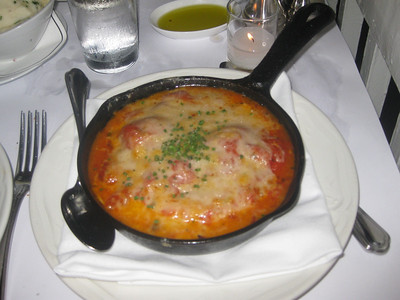
“Stir constantly with a wooden spoon until the cornmeal thickens, about 30 to 45 minutes.” Those instructions have daunted countless would-be polenta makers, including me. Who wants to stand over a steaming pot for 45 minutes, stirring cornmeal non-stop? No doubt anyone who has discovered the tastiness and versatility of this savory comfort food would, that’s who.
A staple of Northern Italian cuisine, modern polenta dates back to the mid 17th century. It was during this time that the Venetians introduced American corn to the region. Prior to the 1600s a variation of polenta was reputedly made using chestnut flour while another version may have existed that employed barley.
Cooked in an unlined copper kettle, the combination of yellow cornmeal, or ground corn, and water was ceaselessly stirred until a thick mush formed. To test for doneness, the cook would insert her wooden spoon in the center of the mixture. If the spoon stood up on its own, without falling over or shifting its position, the polenta was done.
Once finished, the polenta was either served immediately in its porridge-like state or spooned out of the pot, spread out on a flat surface to cool and solidify and then cut into squares. The pieces would then be grilled or fried and paired up with seafood, vegetables or a sauce. An extremely adaptable food, it was offered as a first course, side and even an entrée. When teamed with spicy sausages or sweet syrup or preserves, it became a hearty breakfast.
Although polenta can be delicious on its own, it also compliments a variety of foods. Stewed, braised or roasted meats, grilled fish and shellfish and roasted fowl all couple well with it. When working with meats and fish, be sure to reserve some of their cooking juices so that the liquid can be used as a light sauce for the polenta.
Likewise, polenta can serve as a stand-in for such basic ingredients as the potatoes in mashed potatoes or pasta in lasagna. Just spread out, cool and cut the cooked polenta into strips. Place the strips in a baking dish and cover with cheese, meat or vegetables and tomato sauce and bake. Outstanding!
MEDITERRANEAN POLENTA TRIANGLES
Serves 4 to 6
For the polenta:
3 ¾ cups water
1 tablespoon salt
1 tablespoon olive oil, plus 2 to 3 tablespoons for frying
1 cup instant polenta
For the topping:
1 (14 ½) ounce can of diced tomatoes, drained and with juice reserved in separate bowl
2 cloves garlic, minced
1 tablespoon extra virgin olive oil
2 tablespoons lemon juice
¾ teaspoon dried oregano
¾ teaspoon dried thyme
1 ½ teaspoons fresh, chopped parsley or ¾ teaspoon dried parsley
½ teaspoon ground black pepper
In a large saucepan bring the water to a boil. Add the salt and 1 tablespoon of olive oil. Slowly pour in the cornmeal, stirring with a wooden spoon as you add it. Reduce the heat to medium and continue to cook, stirring constantly, until the mixture thickens, about 5 minutes. Remove from the heat and spoon the polenta into a rectangular, lightly oiled, 2-quart baking dish. Allow the polenta to cool and solidify.
Meanwhile, in a medium bowl mix together the tomatoes, garlic, oil, lemon juice, oregano, thyme, parsley and pepper. Depending on how thick you want the topping to be, add 2 to 4 tablespoons of the reserved tomato juice to the mixture and stir together.
Once the polenta is firm, cut it into triangles about 2 inches in diameter at the base. (You can do this by first cutting the polenta into a rectangle and then slicing it diagonally to make 2 triangles.)
In a non-stick frying pan heat the remaining 2 tablespoons of olive oil. Place several polenta triangles in the pan and fry on both sides until golden brown. Remove and arrange the cooked polenta on a large plate or platter. Repeat these steps with the remaining triangles.
Spoon the topping over the fried polenta and serve immediately.